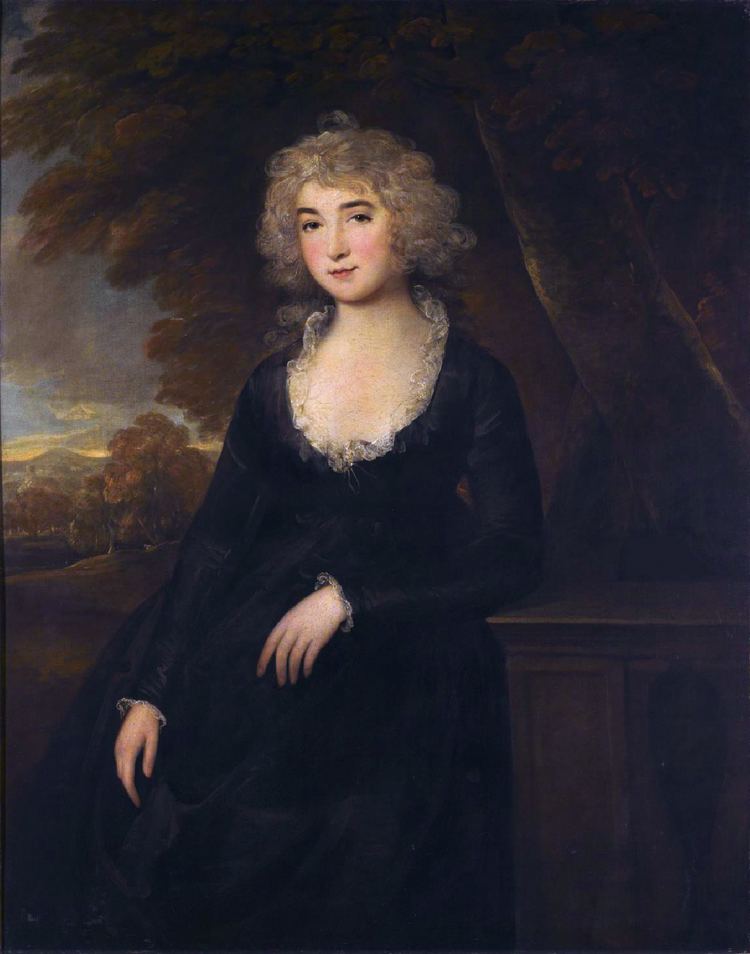Name Frances Countess | ||
 | ||
Died July 23, 1821, Cheltenham, United Kingdom | ||
Frances Villiers, Countess of Jersey (née Twysden; 25 February 1753, St James's – 23 July 1821, Cheltenham) was one of the more notorious of the many mistresses of King George IV when he was Prince of Wales, "a scintillating society woman, a heady mix of charm, beauty, and sarcasm". Through marriage she belonged to the Villiers family.
Contents
Early life
She was born Frances Twysden, second and posthumous daughter of the Rev. Dr Philip Twysden (c.1714–52), Bishop of Raphoe (1746–1752) (died 2 November 1752, allegedly shot while attempting to rob a stagecoach in London) and his second wife Frances Carter (later wife of General Johnston), daughter of Thomas Carter of Castlemartin, Master of the Rolls.
Her disreputable-in-death father was third son of Sir William Twysden, 5th Baronet of Roydon Hall, East Peckham, Kent, by his wife and second cousin Jane Twisden. The Twysden family was convincingly traced from one Roger Twysden living around 1400.
Barely a month past her 17th birthday, she married the 34-year-old new (4th) Earl of Jersey, George Villiers, son and heir of William Villiers, 3rd Earl of Jersey and his wife Lady Anne Egerton who, the year before, had been appointed a Gentleman of the Bedchamber to King George III.
Her husband was appointed Master of Horse to the Prince of Wales in 1795.
Royal affairs
The future George IV began his affair with Lady Jersey, then a 40-year-old grandmother and mother of ten, in 1793. She was also romantically involved with other members of the English aristocracy, including Frederick Howard, 5th Earl of Carlisle. It was not until 1794 that she lured the Prince of Wales away from his "wife", Maria Fitzherbert, with whom he had undergone a form of marriage in a clandestine Church of England ceremony that all parties to it knew was invalid under the Royal Marriages Act 1772.
Having encouraged the Prince of Wales to marry his first cousin, Caroline of Brunswick in 1794, Lady Jersey nevertheless set out to make Caroline's life difficult. However, the now Princess of Wales (Caroline) had very little regard for George IV, nor he for her, and after the birth of their child, they lived apart during their twenty-five year marriage, leaving a void Frances and other mistresses, including Mrs Fitzherbert, continued to fill.
Since Lady Jersey enjoyed the favour of Queen Charlotte, even the displeasure of George III was not enough to threaten Lady Jersey's position, and she continued to run the Prince of Wales' life and household for some time. In about 1803, her previously undisputed place as senior mistress to the Prince of Wales was challenged by his infatuation with Lady Hertford. In 1807, he replaced Lady Jersey, and she would come to have no active involvement with the royal court.
According to Archaeologia Cantiana,
"The home of the Bishop's daughter Frances, Lady Jersey, a favourite of George IV, became a society gambling rendezvous, at which the reputations of her cousins were in no way enhanced.
She had remained married to George Villiers throughout.
Children
Her son George's wife, Sarah (also famous as Lady Jersey), was a leader of the ton during the Regency of the Prince of Wales and his reign as George IV.
Though it may be said the death of her husband—who had narrowly avoided imprisonment in 1802—in 1805 left her without means (to support her rank), her son increased her jointure to £3,500 per annum and settled her debts many times. "her attempts to economize appear to have been unavailing". She died on 25 July 1821 in Cheltenham and was buried at Middleton Stoney in the Villiers family vault.
